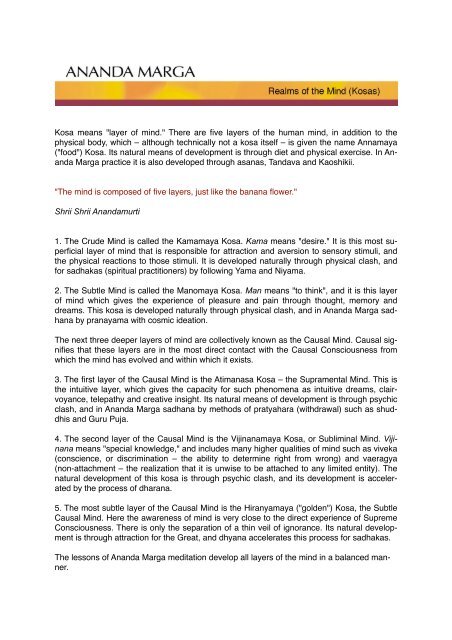Kosa means "layer of mind." There are five layers of ... - Ananda Marga
Kosa means "layer of mind." There are five layers of ... - Ananda Marga
Kosa means "layer of mind." There are five layers of ... - Ananda Marga
You also want an ePaper? Increase the reach of your titles
YUMPU automatically turns print PDFs into web optimized ePapers that Google loves.
<strong>Kosa</strong> <strong>means</strong> "<strong>layer</strong> <strong>of</strong> <strong>mind</strong>." <strong>There</strong> <strong>are</strong> <strong>five</strong> <strong>layer</strong>s <strong>of</strong> the human <strong>mind</strong>, in addition to thephysical body, which – although technically not a kosa itself – is given the name Annamaya("food") <strong>Kosa</strong>. Its natural <strong>means</strong> <strong>of</strong> development is through diet and physical exercise. In <strong>Ananda</strong><strong>Marga</strong> practice it is also developed through asanas, Tandava and Kaoshikii."The <strong>mind</strong> is composed <strong>of</strong> <strong>five</strong> <strong>layer</strong>s, just like the banana flower."Shrii Shrii <strong>Ananda</strong>murti1. The Crude Mind is called the Kamamaya <strong>Kosa</strong>. Kama <strong>means</strong> "desire." It is this most superficial<strong>layer</strong> <strong>of</strong> <strong>mind</strong> that is responsible for attraction and aversion to sensory stimuli, andthe physical reactions to those stimuli. It is developed naturally through physical clash, andfor sadhakas (spiritual practitioners) by following Yama and Niyama.2. The Subtle Mind is called the Manomaya <strong>Kosa</strong>. Man <strong>means</strong> "to think", and it is this <strong>layer</strong><strong>of</strong> <strong>mind</strong> which gives the experience <strong>of</strong> pleasure and pain through thought, memory anddreams. This kosa is developed naturally through physical clash, and in <strong>Ananda</strong> <strong>Marga</strong> sadhanaby pranayama with cosmic ideation.The next three deeper <strong>layer</strong>s <strong>of</strong> <strong>mind</strong> <strong>are</strong> collectively known as the Causal Mind. Causal signifiesthat these <strong>layer</strong>s <strong>are</strong> in the most direct contact with the Causal Consciousness fromwhich the <strong>mind</strong> has evolved and within which it exists.3. The first <strong>layer</strong> <strong>of</strong> the Causal Mind is the Atimanasa <strong>Kosa</strong> – the Supramental Mind. This isthe intuitive <strong>layer</strong>, which gives the capacity for such phenomena as intuitive dreams, clairvoyance,telepathy and creative insight. Its natural <strong>means</strong> <strong>of</strong> development is through psychicclash, and in <strong>Ananda</strong> <strong>Marga</strong> sadhana by methods <strong>of</strong> pratyahara (withdrawal) such as shuddhisand Guru Puja.4. The second <strong>layer</strong> <strong>of</strong> the Causal Mind is the Vijinanamaya <strong>Kosa</strong>, or Subliminal Mind. Vijinana<strong>means</strong> "special knowledge," and includes many higher qualities <strong>of</strong> <strong>mind</strong> such as viveka(conscience, or discrimination – the ability to determine right from wrong) and vaeragya(non-attachment – the realization that it is unwise to be attached to any limited entity). Thenatural development <strong>of</strong> this kosa is through psychic clash, and its development is acceleratedby the process <strong>of</strong> dharana.5. The most subtle <strong>layer</strong> <strong>of</strong> the Causal Mind is the Hiranyamaya ("golden") <strong>Kosa</strong>, the SubtleCausal Mind. Here the aw<strong>are</strong>ness <strong>of</strong> <strong>mind</strong> is very close to the direct experience <strong>of</strong> SupremeConsciousness. <strong>There</strong> is only the separation <strong>of</strong> a thin veil <strong>of</strong> ignorance. Its natural developmentis through attraction for the Great, and dhyana accelerates this process for sadhakas.The lessons <strong>of</strong> <strong>Ananda</strong> <strong>Marga</strong> meditation develop all <strong>layer</strong>s <strong>of</strong> the <strong>mind</strong> in a balanced manner.
The development <strong>of</strong> <strong>mind</strong> is a process <strong>of</strong> clash and cohesion. Whenever an action is performedit creates an impression, or potential reaction, in the <strong>mind</strong>. This is called samskara –the distortion <strong>of</strong> <strong>mind</strong> waiting for expression. In order to express one's samskaras, differentexperiences (some pleasurable and others painful) will have to be encountered, dependingon the samskaras to be expressed. But regardless <strong>of</strong> whether the experiences <strong>are</strong> pleasurableor painful, from a spiritual viewpoint they <strong>are</strong> always desirable because they facilitatethe exhaustion <strong>of</strong> one's samskaras – hence the purification <strong>of</strong> <strong>mind</strong> and consequent increaseddesire for cosmic merger. So obstacles and hardship <strong>are</strong> considered beneficial onthe spiritual path. For the optimal progress, therefore, spiritual practice must be combinedwith worldly struggle, and this preferably in the form <strong>of</strong> social service."It is a bigger thing to put one lesson into action than to hear many.You should put into action every lesson <strong>of</strong> your life."Shrii Shrii <strong>Ananda</strong>murtiwww.anandamarga.org<strong>Ananda</strong> <strong>Marga</strong> – “Path <strong>of</strong> Bliss”Copyright © 2006 <strong>Ananda</strong> <strong>Marga</strong> Pracaraka SamghaAll rights reserved


